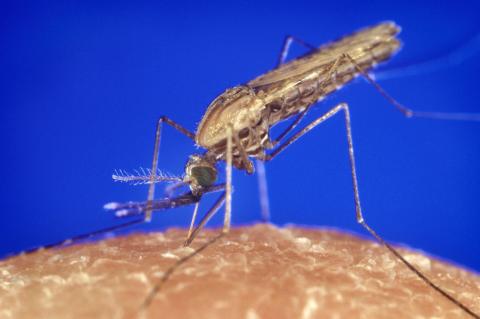Dangerous Bites
Researchers Discuss Impact of Climate Change on Mosquito-Borne Diseases

Photo: James Gathany / Shutterstock
In some parts of the world, mosquito bites are simply a nuisance, leaving itchy welts that disappear in a few days. But in other areas, mosquito bites can transmit serious, sometimes lethal pathogens. The more dangerous species thrive in tropical regions. That begs the question: As the planet heats up in the coming decades, how will climate change affect these mosquito populations and disease spread?
Two NIH-funded investigators recently discussed the mosquito-temperature connection as it relates to such diseases as malaria, dengue, Zika and chikungunya. They spoke at a virtual NIAID seminar in August to mark World Mosquito Day, which is recognized annually on Aug. 20, the anniversary of the discovery in 1897 that Anopheles mosquitoes transmit the parasite that causes malaria.
Certain temperatures raise the risk for mosquitoes to spread disease; other temperatures are suboptimal. Interestingly though, some conditions are too hot so further warming could drive disease transmission down, said Dr. Matthew Thomas, professor of entomology and nematology at the University of Florida. He focused his talk on mosquitoes that spread malaria, which globally causes 240 million infections and 627,000 deaths annually, according to the World Health Organization.

Looking ahead, rising temperatures reducing transmission is not universally good news. In 30-50 years, based on a heat map accounting for thermal performance and population density, higher temperatures likely will move malaria to higher altitudes, said Dr. Elizabeth McGraw, professor and department head of biology at Penn State University. But mosquitoes that spread dengue are more heat tolerant, so the virus is expected to continue spreading in sub-Saharan Africa.
Understanding the biology and movement of different mosquito species and their adaptive potential can help predict and inform responses to environmental change. “Surveillance is a really important part of informing control practices,” said McGraw.
The risk of disease transmission depends on a range of factors. For malaria, the region must contain the specific mosquito species and malaria parasites. How efficiently and fast those parasites incubate the mosquitoes, and mosquito density, lifespan and biting rate are also factors.
“All of those life history traits are strongly temperature-dependent” and the potential impact is stark, said Thomas.
A recent Lancet Planetary Health paper, looking at control capacity under multiple warming scenarios, estimated the at-risk population for malaria and dengue may increase by 4 billion to 7 billion people by 2070.
While current and future climate will affect mosquito and parasite biology, “temperature is not the only driver of change,” Thomas said. Other environmental factors include rainfall, humidity, land use and human population density.
Some places have better control measures—access to medicines, housing with air conditioning and window screens. But many areas where malaria prevails are poverty-stricken, lacking the capacity to mitigate transmission.
“Urbanization, socio-economic growth and control interventions are all important factors,” Thomas said.

One more immediate effect on transmission is occurring among mosquito species that tend to feed and rest indoors, given the transition from thatched to modern, metal-roofed houses, which get much hotter during the day.
“This is significant because you can change the internal temperature of your house overnight,” said Thomas, “and this is happening in Africa now.”
Thomas’s lab simulated heat ranges between thatched and metal-roofed houses and compared two infected mosquito species: Anopheles gambiae, a key African malaria vector in rural areas, and Anopheles stephensi, a mainly urban species that has recently invaded Africa from Asia.
The warming temperatures decreased disease transmission for both mosquito species. At the highest temperature, 33 degrees Celsius, his lab demonstrated potential for Anopheles stephensi to transmit malaria, but not Anopheles gambiae.
“Anopheles stephensi has higher thermal tolerance and a capacity to transmit at higher temperatures than Anopheles gambiae,” said Thomas, “and that’s important when we’re thinking about climate change and also thinking about the invasion of this species into Africa. Now, we might have an interaction between invasive species and climate change, changing the dynamics and distribution of malaria.”
Thomas and McGraw have been collaborating on experiments to test thermal performance and the mosquitoes’ ability to adapt in different conditions. They looked at two species of Aedes mosquitoes, which can carry dengue, chikungunya, Zika and yellow fever.
Taking Aedes aegypti from Mexico and Aedes albopictus from multiple U.S. locations, they put the mosquitoes in glass vials in an incubator at different temperatures. They found significant variation in thermal tolerance among populations of the two species. The mosquitoes from environments with higher maximum temperatures were more thermally tolerant.
“This provides some of the first evidence for local thermal adaptation,” said Thomas, “and an impact in mosquito phenotype associated with local temperatures” for both Aedes species.

The team also conducted a similar experiment on mosquitoes infected with Wolbachia—bacteria that reduce the ability of arboviruses to replicate inside mosquitoes, released as part of large global mosquito-control programs.
Using Wolbachia, “you can really change the local mosquito population,” said McGraw, “and these mosquitoes should be largely resistant to transmitting pathogens…But it is a biological organism just like the virus, and just like the mosquito, so it has its own thermal tolerance ranges.”
The experiments showed Wolbachia loads decline at very high temperatures, as does maternal transmission. “There is concern that in regions of extreme temperatures, you might have Wolbachia disappear out of populations,” thereby impeding mosquito control efforts, said McGraw.
In another experiment, her lab took dengue and grew it for many generations in mosquito cells at 25 and 37 degrees Celsius—temperatures commonly experienced by this virus. Early data showed that after passaging at 37 degrees, the virus grew more quickly but lost the capacity to grow well at 25 degrees. The genetic changes in virus that occurred during the passaging, interestingly, left it less able to infect mosquitoes.
“What this suggests,” she said, “is that there might be trade-offs in terms of thermal tolerance and infectivity that could hugely affect the landscape of transmission in the field.”
McGraw and Thomas emphasized that more work is needed to test different mosquito species in a broad range of conditions that incorporate mosquito biology, human behavior and natural environment variation.
“There’s a lot more work to do,” said McGraw, “to understand the basic landscape of transmission and vector fitness across these complex and changeable environments.”
